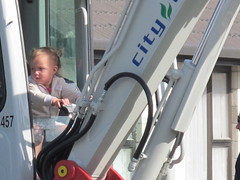
Search
Images for Rebuild Christchurch; more images...
Setting national standards for utilities coordination and protection - SCI…
Articles, UC QuakeStudies
A document which describes how SCIRT led the co-ordination of its huge repair programme with those of other utilities.
Driving Innovative Thinking in the New Zealand Construction Industry - pre…
Articles, UC QuakeStudies
A pdf copy of a presentation delivered at Building a Better New Zealand (BBNZ 2014) Conference. The presentation examines the relationship between innovation and productivity improvement in the construction industry.
Pipe Lining Specification
Articles, UC QuakeStudies
A document which specifies the technical requirements for the rehabilitation and repair of pipes using lining methodologies during the SCIRT programme of work.
CTV News - SCIRT Women
Videos, UC QuakeStudies
A video of a CTV News broadcast of a Ministry of Women's Affairs initiative to attract more women into trades and construction related jobs.
SCIRT Health and Safety Policy - February 2016
Articles, UC QuakeStudies
The SCIRT Health and Safety Policy, revised in February 2016.
SCIRT, The Construction Industry Health and Safety Leaders - paper
Articles, UC QuakeStudies
A final year paper prepared by University of Canterbury students examining the positive effects of SCIRT on the New Zealand construction industry's health and safety performance.
Critical Risk 6 Health and Safety Toolbox - confined spaces
Articles, UC QuakeStudies
A document which outlines how to work safely in confined spaces, created to discuss with site staff at on-site "toolbox talks".
SCIRT Safety Alert - SCIRT Critical Risk #3 powered plant and tools - firs…
Articles, UC QuakeStudies
An example of a SCIRT safety alert. Safety alerts were sent out to Delivery Team Health and Safety representatives after an incident who then sent or delivered them to subcontractors.
SCIRT safety on a page
Articles, UC QuakeStudies
A document which illustrates the impetus for SCIRT's zero harm programme, the parties involved, initiatives undertaken and outcomes achieved.
Critical Risk 5 Health and Safety Toolbox - trenches and excavations
Articles, UC QuakeStudies
A document which outlines how to work safely in trenches and excavations, created to discuss with site staff at on-site "toolbox talks".
Critical Risk 4 Health and Safety Toolbox - lifting operations
Articles, UC QuakeStudies
A document which outlines how to safely carry out lifting operations, created to discuss with site staff at on-site "toolbox talks".
Critical Risk 8 Health and Safety Toolbox - working at height and depth
Articles, UC QuakeStudies
A document which outlines how to work safely at height and depth, created to discuss with site staff at on-site "toolbox talks".
Critical Risk 2 Health and Safety Toolbox - mobile plant and people interf…
Articles, UC QuakeStudies
A document which outlines how to keep site staff and public safe around mobile plant, created to discuss with site staff at on-site "toolbox talks".
Critical Risk 3 Health and Safety Toolbox - traffic management and people …
Articles, UC QuakeStudies
A document which outlines how to keep site staff and public safe around traffic, created to discuss with site staff at on-site "toolbox talks".
Health and Safety Management Plan
Articles, UC QuakeStudies
A plan which aims to ensure an environment of Zero Harm on SCIRT worksites. The first version of this plan was produced on 29 July 2011.
Monthly SCIRT Safety Statistics - December 2016
Articles, UC QuakeStudies
An example of a monthly presentation created to communicate with all SCIRT team members about SCIRT's safety performance.
The SCIRT Innovation Project
Articles, UC QuakeStudies
A report created by the University of Canterbury Quake Centre and the University of Auckland, funded by the Building Research Levy. It shows how an innovation process was initiated and managed throughout the rebuilding of the horizontal infrastructure after the Canterbury earthquakes.
Earthquake Expectation Data
Articles, UC QuakeStudies
A paper which details earthquake expectation data, supplied to SCIRT by GNS Science.
SCIRT and New Zealand Red Cross collaboration workshop summary
Articles, UC QuakeStudies
A document created to summarise the initial SCIRT and New Zealand Red Cross collaboration workshop.
SCIRT presentation to Red Cross
Articles, UC QuakeStudies
A pdf copy of a presentation which SCIRT presented to Red Cross volunteers, telling them about what SCIRT is and what it does.
'REAL' response to resource roles
Articles, UC QuakeStudies
A document which outlines SCIRT's best practice approach to recruitment and training.
Peak performance coaching at SCIRT
Articles, UC QuakeStudies
A document which outlines SCIRT's use of peak performance coaches.
Peak performance coaching booklet
Articles, UC QuakeStudies
A booklet which describes SCIRT's reasons for using peak performance coaches, and introduces each coach.
Intentionally creating a culture of high performance and resilience
Articles, UC QuakeStudies
A presentation given to Human Resource Institute of New Zealand members, outlining SCIRT's intentional approach to culture development.
Design thinking flipcharts
Articles, UC QuakeStudies
A document containing the flipcharts from the SCIRT and the New Zealand Red Cross design thinking workshop.
Humaneers action learning group presentation - Humaneers - Prioritisation
Articles, UC QuakeStudies
A pdf copy of a presentation delivered by Elizabeth McNaughton and Duncan Gibb at the SCIRT and New Zealand Red Cross humaneers action learning group.
Mind the gap: more workers wanted
Articles, UC QuakeStudies
A document which describes the process that SCIRT took to fill its operational workforce gap.
SCIRT leaving a legacy of an improved training framework for trades
Articles, UC QuakeStudies
A paper which outlines what had been achieved by SCIRT's Training Team, and proposing an approach to ensure that the learnings from SCIRT be transferred to wider industry.
Hays NAWIC Excellence Awards 2015 submission: Category: Professional Woman…
Articles, UC QuakeStudies
An award submission nominating Paula Lock for the Hays NAWIC Excellence Awards 2015: Category: Professional Woman of the Year.
Hays NAWIC Excellence Awards 2015 submission: Category: Helen Tippett Award
Articles, UC QuakeStudies
An award submission nominating SCIRT Women in Construction (SWIC) for the Hays NAWIC Excellence Awards 2015: Category: Helen Tippett Award.



